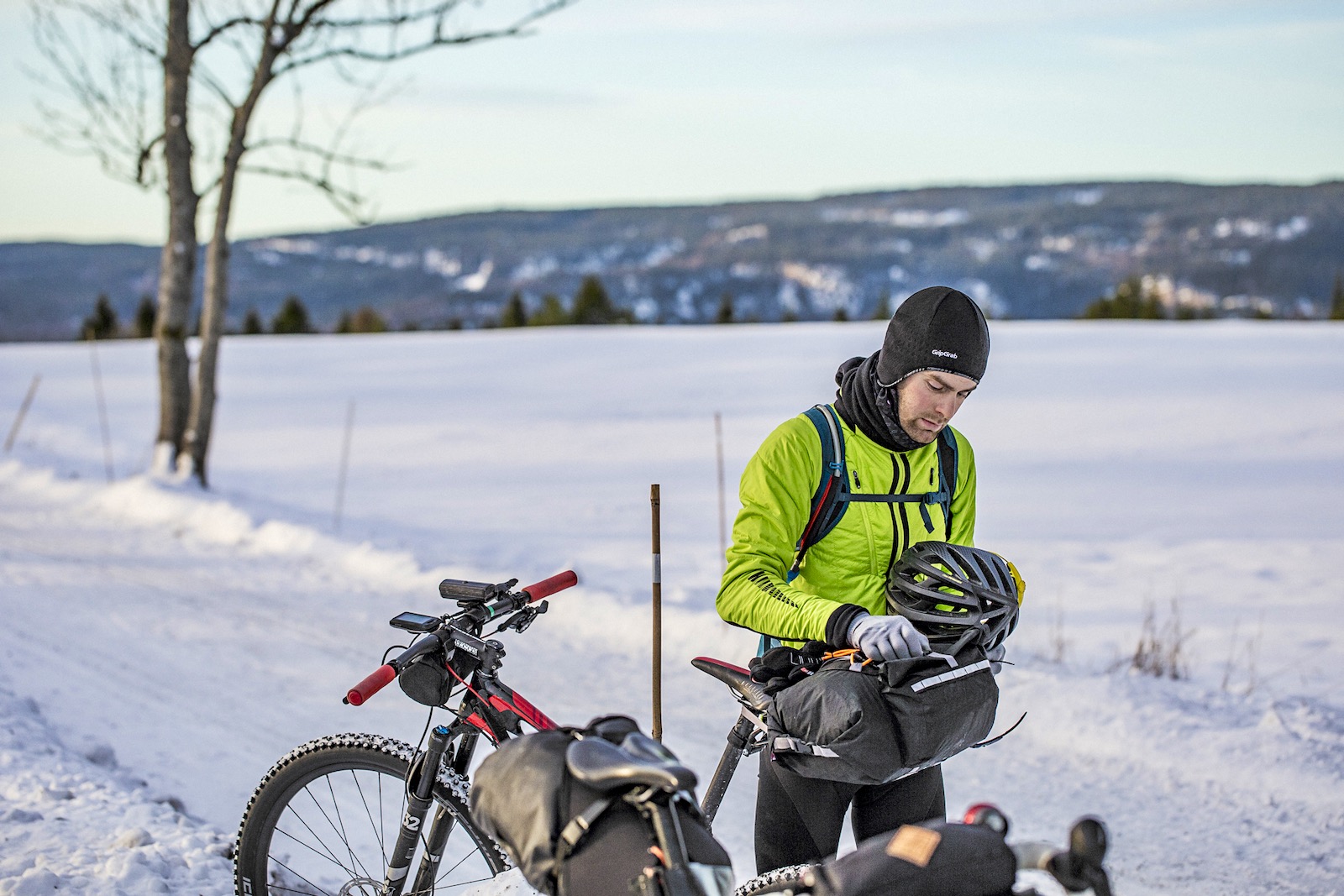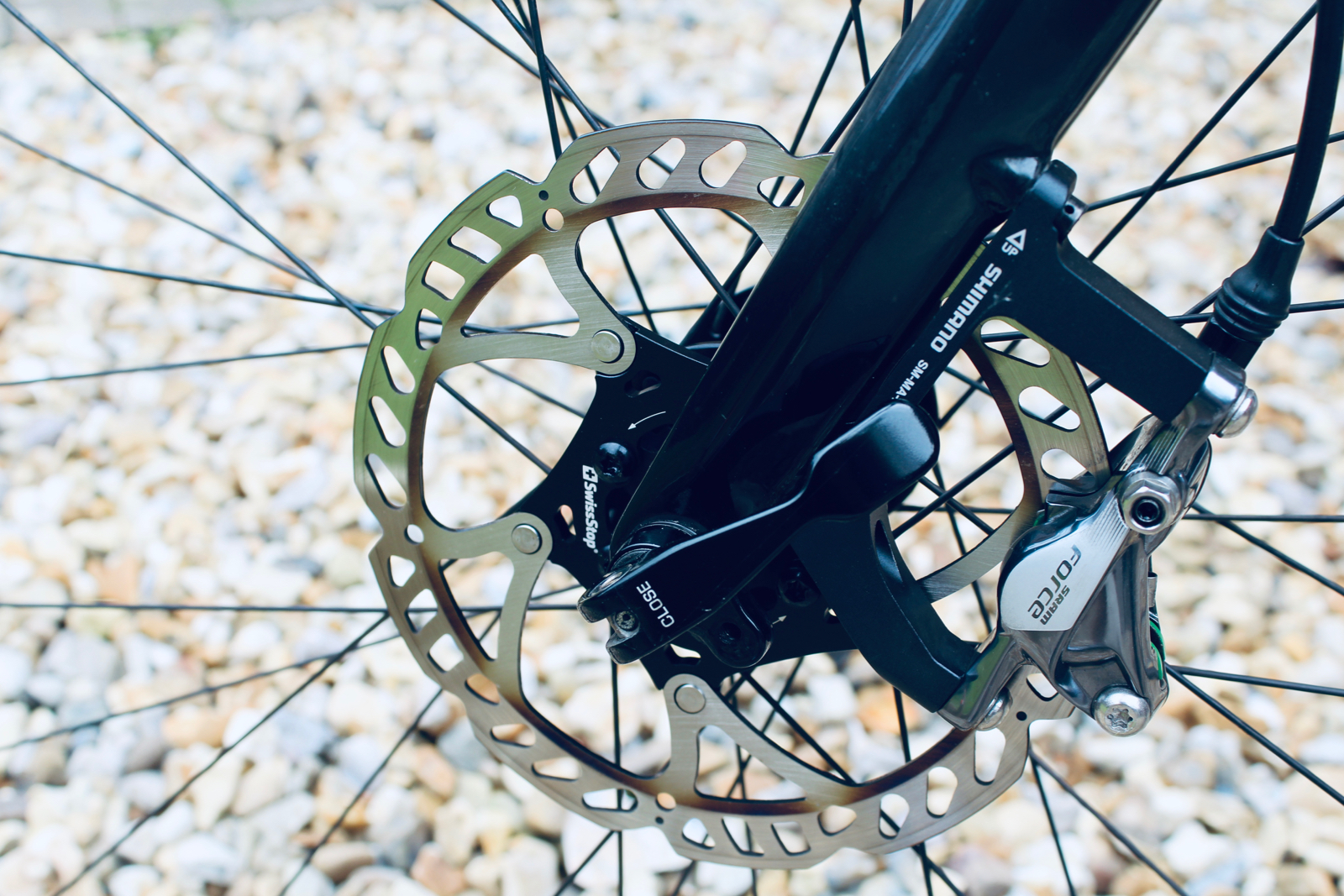Kit Tips – A Guide to Cold Weather Winter Cycle Clothing
Low temperatures and winter storms push wind-chill factors to sub-zero. Bike riding does not have to cease in freezing conditions though; with the right clothing, there is no reason not to enjoy your cycling, even in the chilly months of winter.
In this blog post, I offer my tips and advice for the right clothing to keep you comfortable when cycling in the depths of winter…
Your hands are an extremity—they are one of the furthest points from the central boiler pump that is your heart. In order to keep them warm, you need to keep the blood that is flowing to them warm.
Protecting your lower arms from wind-chill and insulating them with a long sleeve base layer will aid warm blood flows down your arteries all the way to your hands.
The best long sleeve winter cycling base layer I have used is the GripGrab Expert Seamless Thermal Long Sleeve Cycling Base Layer.
Proper winter cycling bib tights are fleece lined and often have a windproof outer coating—this helps to keep the elements at bay and insulate you from the cold. Winter bib tights also have an advantage over a bib short and leg warmers combination because they tend to be higher cut and a thicker fabric than bib shorts; this keeps your body's core temperature at a stable and comfortable level.
For the most comfortable and warmest winter tights, I recommend the GripGrab ThermaShell Winter Bib Tights
A good winter jacket will have a high-cut neck and soft well-fitted cuffs to seal in the warmth. The best winter cycling jackets also have features such as larger zip pulls for use with full-finger winter gloves and larger pockets for extra fuel on long winter rides.
One of my favourite winter jackets is the GripGrab ThermaShell SoftShell Jacket
When combined with a proper winter jacket, winter cycling gloves significantly improve your comfort riding in sub-zero conditions; they are also fundamental to safety when you need to feather the brakes on those slippery descents.
There are two pairs of deep winter cycling gloves that I would never go without…
The GripGrab Polaris 2 Winter Cycling Gloves are the ultimate deep winter protection. The membrane technology creates a waterproof and windproof barrier against rain, wind, and snow; whilst the Primaloft hollow-fibre insulation construction protects your fingers from the sub-zero. Long cuffs provide a complete seal with your winter jacket and silicone grippers on the padded palms provide you with a firm grip even in icy conditions.
The GripGrab Nordic 2 Lobster Winter Cycling Gloves are then my choice for very severe winter windchill conditions, but when there is less risk of precipitation. These gloves are not waterproof, but they are windproof and incredibly warm. The proven lobster mitt design—like the classic mittens you had as a child—means the fingers are clustered together to share their warmth, but the index finger remains free to use the brake lever and shifters. The Nordic 2 also features a silicone grip padded palm for extra grip and comfort, and a closure cuff to seal out the weather and seal in the warmth. Adding a pair of merino wool liners to these gloves creates the ultimate winter cycling glove—highly breathable, but super protective.
Overshoes come in a variety of thicknesses and materials, and when things get really cold, I recommend going fleece-lined...
I wear mountain bike shoes in the winter, even on the road; because they have fewer mesh vents that can let out valuable warmth and let in moisture. With this in mind, I opt for the off-road specific GripGrab Arctic X Overshoes for the coldest winter months.
The GripGrab Arctic Shoe Covers (Road) and GripGrab Arctic X Shoe Covers (MTB) are made from 4 mm thick fleece-lined neoprene—to give maximum protection and thermal insulation. The zipper-less cuff design avoids those leaking and irritating zips, and creates a closer fit around your ankle; whilst these overshoes also feature GripGrab's award-winning IntelliSeal technology to create a much-improved waterproof seal against the shoe's sole.
The ultimate protection for your feet…
Wearing a balaclava or a fleecy helmet cap will help to insulate your head from the cold. I choose the GripGrab Aviator Cap in the winter or the GripGrab Balaclava; because the thick thermal fleece and windproof properties make a huge difference to keeping your head warm and comfortable.
Avoid brain freeze, and layer up smart this winter...
In this blog post, I offer my tips and advice for the right clothing to keep you comfortable when cycling in the depths of winter…
1 – Long Sleeve Base Layers
Cold hands when cycling in low temperatures? Long sleeve base layers are the key to comfort here.Your hands are an extremity—they are one of the furthest points from the central boiler pump that is your heart. In order to keep them warm, you need to keep the blood that is flowing to them warm.
Protecting your lower arms from wind-chill and insulating them with a long sleeve base layer will aid warm blood flows down your arteries all the way to your hands.
The best long sleeve winter cycling base layer I have used is the GripGrab Expert Seamless Thermal Long Sleeve Cycling Base Layer.
2 – Thermal Winter Cycling Bib Tights
Just like your hands, your feet are a vulnerable extremity in the cold. Keeping warm blood flowing down the length of your legs will help to keep your feet warm and avoid knee pain in cold conditions.Proper winter cycling bib tights are fleece lined and often have a windproof outer coating—this helps to keep the elements at bay and insulate you from the cold. Winter bib tights also have an advantage over a bib short and leg warmers combination because they tend to be higher cut and a thicker fabric than bib shorts; this keeps your body's core temperature at a stable and comfortable level.
For the most comfortable and warmest winter tights, I recommend the GripGrab ThermaShell Winter Bib Tights
3 – Windproof Thermal Winter Cycling Jackets
Windchill is the real enemy in the coldest months. A windproof and thermal cycling jacket will keep the wind off your vulnerable torso and insulate your body from the cold temperatures.A good winter jacket will have a high-cut neck and soft well-fitted cuffs to seal in the warmth. The best winter cycling jackets also have features such as larger zip pulls for use with full-finger winter gloves and larger pockets for extra fuel on long winter rides.
One of my favourite winter jackets is the GripGrab ThermaShell SoftShell Jacket
4 – Winter Cycling Gloves
Keeping dexterity in your hands is vital to comfort and control when you are riding in the coldest conditions. The fabric technology required to make a glove windproof, waterproof, and breathable are complex; this means that proper winter cycling gloves will be an expensive but worthwhile investment.When combined with a proper winter jacket, winter cycling gloves significantly improve your comfort riding in sub-zero conditions; they are also fundamental to safety when you need to feather the brakes on those slippery descents.
There are two pairs of deep winter cycling gloves that I would never go without…
The GripGrab Polaris 2 Winter Cycling Gloves are the ultimate deep winter protection. The membrane technology creates a waterproof and windproof barrier against rain, wind, and snow; whilst the Primaloft hollow-fibre insulation construction protects your fingers from the sub-zero. Long cuffs provide a complete seal with your winter jacket and silicone grippers on the padded palms provide you with a firm grip even in icy conditions.
The GripGrab Nordic 2 Lobster Winter Cycling Gloves are then my choice for very severe winter windchill conditions, but when there is less risk of precipitation. These gloves are not waterproof, but they are windproof and incredibly warm. The proven lobster mitt design—like the classic mittens you had as a child—means the fingers are clustered together to share their warmth, but the index finger remains free to use the brake lever and shifters. The Nordic 2 also features a silicone grip padded palm for extra grip and comfort, and a closure cuff to seal out the weather and seal in the warmth. Adding a pair of merino wool liners to these gloves creates the ultimate winter cycling glove—highly breathable, but super protective.
5 – Fleece-Lined Neoprene Overshoes
If you have not used overshoes before, then you are missing out—shoe covers help to keep spray and windchill off your vulnerable feet.Overshoes come in a variety of thicknesses and materials, and when things get really cold, I recommend going fleece-lined...
I wear mountain bike shoes in the winter, even on the road; because they have fewer mesh vents that can let out valuable warmth and let in moisture. With this in mind, I opt for the off-road specific GripGrab Arctic X Overshoes for the coldest winter months.
The GripGrab Arctic Shoe Covers (Road) and GripGrab Arctic X Shoe Covers (MTB) are made from 4 mm thick fleece-lined neoprene—to give maximum protection and thermal insulation. The zipper-less cuff design avoids those leaking and irritating zips, and creates a closer fit around your ankle; whilst these overshoes also feature GripGrab's award-winning IntelliSeal technology to create a much-improved waterproof seal against the shoe's sole.
The ultimate protection for your feet…
6 – Merino Wool Socks and Liner Gloves
There is a saying in Norwegian: 'Ull er Gull'—'Wool is Gold'. They know what they are talking about—the photos in this blog post were taken a bikepacking trip in Norway, when the temperatures bottomed out at -14ºC.In the winter months, wool clothing (especially merino wool) is a superb choice.
Because wool stays warm and insulating even when wet, it is the ideal choice for your hands and feet. Inside my winter cycling shoes, I wear GripGrab Winter Socks that have a wool blend to deliver these insulating benefits. On particularly wintry days, I also use GripGrab's Primavera Merino Mid-Season Gloves inside my Nordic 2 Lobster Gloves to provide added comfort and insulation.
Because wool stays warm and insulating even when wet, it is the ideal choice for your hands and feet. Inside my winter cycling shoes, I wear GripGrab Winter Socks that have a wool blend to deliver these insulating benefits. On particularly wintry days, I also use GripGrab's Primavera Merino Mid-Season Gloves inside my Nordic 2 Lobster Gloves to provide added comfort and insulation.
7 – Winter Cycling Headwear
Finally, to top things off... do not forget your head. This is also an extremity, and one of the greatest sources of heat loss in freezing conditions.Wearing a balaclava or a fleecy helmet cap will help to insulate your head from the cold. I choose the GripGrab Aviator Cap in the winter or the GripGrab Balaclava; because the thick thermal fleece and windproof properties make a huge difference to keeping your head warm and comfortable.
Avoid brain freeze, and layer up smart this winter...













Comments
Post a Comment